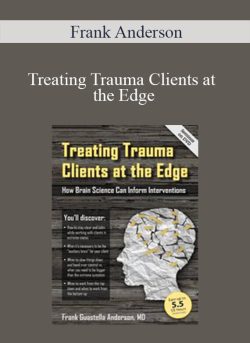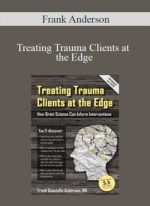Frank Anderson – Treating Trauma Clients at the Edge: How Brain Science Can Inform InterventionsTherapists often get shaken and lose confidence in their approach when a client’s trauma response edges into seemingly uncontrollable extremes of rage, panic, or suicidal desperation. This workshop provides an essential road map for treating difficult trauma cases through a detailed exploration of the neurobiological processes of hyperarousal and parasympathetic withdrawal underlying extreme symptoms. You’ll discover:How to stay clear and calm while working with clients in extreme statesWhen it’s necessary to be the “auxiliary brain” for your clientWhen to slow things down and hand over control vs. when you need to be bigger than the extreme symptomWhen to work from the top-down and when to work from the bottom-upHandouts/BrochureSlides – Treating Trauma Clients at the Edge: How Brain Science Can Inform Interventions (0.71 MB) 11 Pages Available after PurchaseOutlineExperiential Treatments – Integrating neuroscience and psychotherapyNecessity of utilizing physical, emotional and relationship aspects in therapeutic interventionProblems with traditional phase oriented treatmentNegative evaluation of symptoms – ignoring their protective functionInternal Family SystemsUnderstanding symptom presentation as positive efforts pushed to extremesWelcoming and integrating all parts of an individualIdentifying intent of symptomology, importance of avoiding shamingRedefining trauma related diagnoses and integrating overactive protective mechanismsDisorganized attachmentBorderline Personality Disorder, Dissociative Identity DisorderTherapist factors – vulnerabilitiesImpact of therapist parts acting as separately as the clients we work withResponding effectively to personal triggersSymptoms of post traumaHyperarousal, hyperarousal, psychic woundsImportance of obtaining permission before addressing psychic woundsExperiential exercise – self-awareness, response to triggersMind-brain relationshipsNeuroplasticity, neural integrationNeural networks associated with traumaImplicit nature of trauma memoriesAutonomic nervous systemRole of cortisolSympathetic hyper-arousalCharacteristics of extreme symptom activation and mixed statesTherapeutic responsesChoosing compassion or empathic responsesProviding auxiliary cognitionStrategies to avoid contributing to hyperarousalTop down strategies to separate or unblendCase presentation – example of permission seeking, direct access and unblendingPolyvagal TheoryDorsal and ventral branchesActivating strategies, responding to hypo-arousal, bluntingSpeakerFrank Anderson, MDFrank Anderson, MD, completed his residency and was a clinical instructor in psychiatry at Harvard Medical School. He is both a psychiatrist and psychotherapist. He specializes in the treatment of trauma and dissociation and is passionate about teaching brain-based psychotherapy and integrating current neuroscience knowledge with the IFS model of therapy.Dr. Anderson is a Lead Trainer at the IFS Institute with Richard Schwartz and maintains a long affiliation with, and trains for, Bessel van der Kolk’s Trauma Center. He serves as an advisor to the International Association of Trauma Professionals (IATP) and was the former chair and director of the Foundation for Self-Leadership.Dr. Anderson has lectured extensively on the Neurobiology of PTSD and Dissociation and wrote the chapter “Who’s Taking What” Connecting Neuroscience, Psychopharmacology and Internal Family Systems for Trauma in Internal Family Systems Therapy – New Dimensions. He co-authored a chapter on What IFS Brings to Trauma Treatment in Innovations and Elaborations in Internal Family Systems Therapy, and recently co-authored Internal Family Systems Skills Training Manual.His most recent book, entitled Transcending Trauma: Healing Complex PTSD with Internal Family Systems was released on May 19, 2021.Dr. Anderson maintains a private practice in Concord, MA. www.FrankAndersonMD.comSpeaker Disclosures: Financial: Dr. Frank Anderson maintains a private practice. He is the executive director of the Foundation for Self Leadership and has employment relationships with The Trauma Center and The Center for Self Leadership. Dr. Anderson receives royalties as a published author. He receives a speaking honorarium, recording, and book royalties from PESI, Inc. He has no relevant financial relationships with ineligible organizations. Non-financial: Dr. Frank Anderson is a member of the New England Society Studying Trauma and Dissociation and the International Society for the Study of Trauma and Dissociation.Salepage: https://catalog.pesi.com/item/23153/ Archive: https://archive.fo/wip/QUegtDelivery Method– After your purchase, you’ll see a View your orders link which goes to the Downloads page. Here, you can download all the files associated with your order. – Downloads are available once your payment is confirmed, we’ll also send you a download notification email separate from any transaction notification emails you receive from Forimc.me. – Since it is a digital copy, our suggestion is to download and save it to your hard drive. In case the link is broken for any reason, please contact us and we will resend the new download link. – If you cannot find the download link, please don’t worry about that. We will update and notify you as soon as possible at 8:00 AM – 8:00 PM (UTC+8).Thank You For Shopping With Us! Reviews There are no reviews yet.Be the first to review “Frank Anderson – Treating Trauma Clients at the Edge: How Brain Science Can Inform Interventions” Cancel replyYour rating *Rate…PerfectGoodAverageNot that badVery poorYour review *Name *Email *Δ
 John Gibbons – The Vital Shoulder Complex
₹36,022.00
John Gibbons – The Vital Shoulder Complex
₹36,022.00
 Stacey Mayo – Upleveled Grace Healer Training
₹26,394.00
Stacey Mayo – Upleveled Grace Healer Training
₹26,394.00
Frank Anderson – Treating Trauma Clients at the Edge: How Brain Science Can Inform Interventions
₹7,304.00






